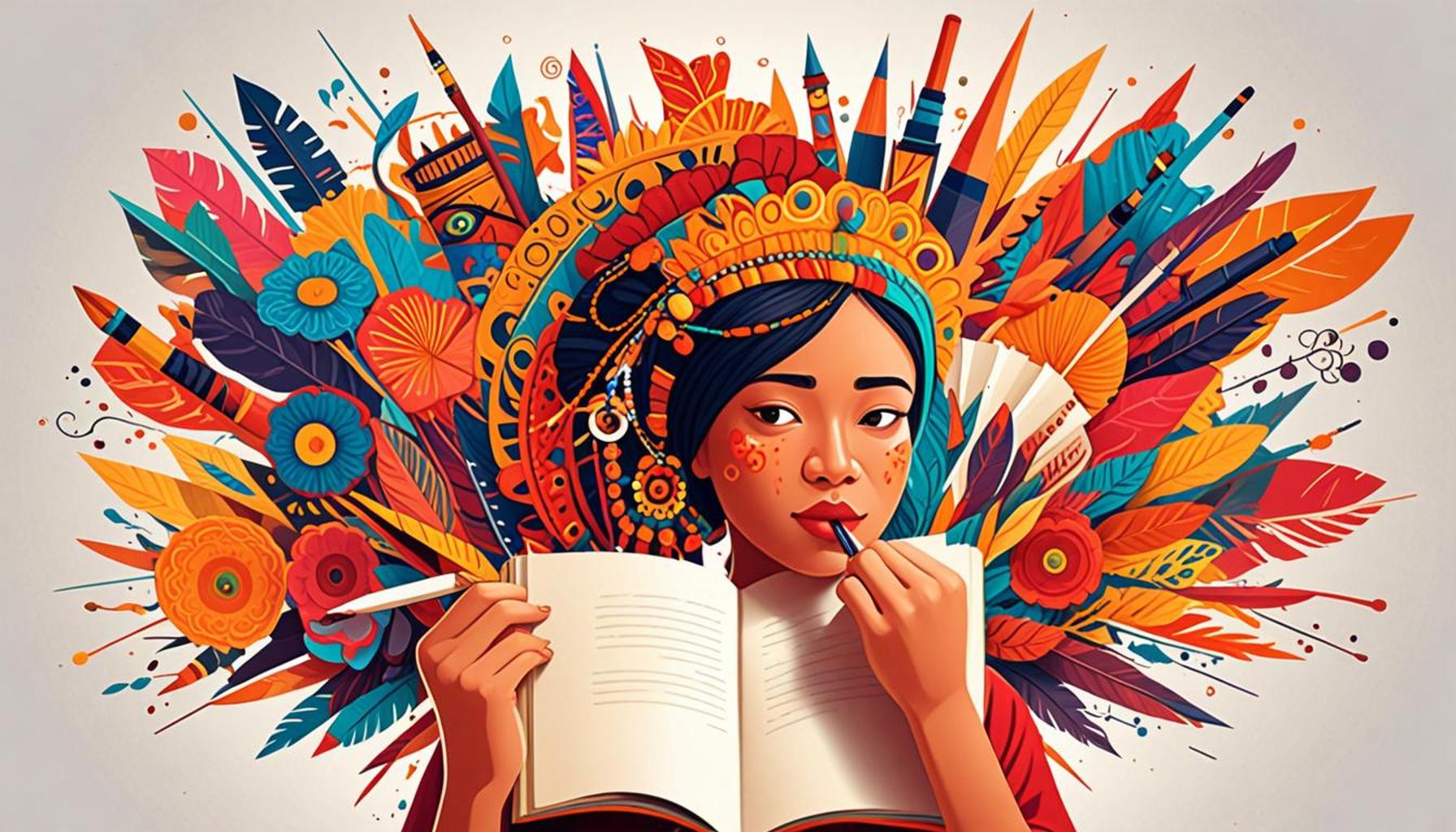The Influence of Culture on Writing: How to Incorporate Cultural Elements to Enrich Your Narratives

Culture as the Heartbeat of Storytelling
To truly understand the essence of storytelling, one must recognize that culture shapes our perceptions, experiences, and ultimately our narratives. Writers who embrace their cultural contexts can weave richer, more intimate stories that resonate deeply with readers. This is particularly true for authors in Nigeria, where a tapestry of diverse cultures, languages, and histories offers endless possibilities for vibrant storytelling.
Why Infuse Cultural Elements?
Incorporating cultural elements into writing serves several critical functions:
- Enhance authenticity: Readers often feel more connected to narratives that reflect their own societal norms and values. For instance, a story set in the bustling markets of Lagos, filled with the sounds of hawkers and the rich aroma of jollof rice, may resonate with locals, providing a sense of place that elevates the reading experience.
- Broaden perspectives: By introducing cultural practices and viewpoints that may be unfamiliar to some readers, authors can promote empathy and understanding. A narrative that explores the traditional rites of the Edo people, for example, can offer insights into their values and beliefs, expanding the readers’ worldview.
- Encourage relatability: Culturally enriched narratives allow readers from similar backgrounds to connect on a personal level. The portrayal of family dynamics during significant celebrations like Eid or Christmas in Nigeria creates familiarity and a sense of shared experience.
Examples of Cultural Elements
As you write, consider infusing the following cultural elements into your work:
- Language and Dialect: Regional dialects, such as Yoruba, Igbo, or Hausa, can bring authenticity to dialogue. Characters who respond with “Bawo ni?” or use colloquial terms can create a palpable sense of setting.
- Traditions and Folklore: Incorporating traditional myths, like the stories of Anansi the spider or the significance of Masquerade festivals, adds layers to character motivations and plot structures, helping to illustrate broader societal themes.
- Cuisine and Lifestyle: Describing local delicacies, whether it’s the spicy suya grilled over an open flame or rich pounded yam, not only captivates the senses but can also symbolize cultural values and practices, signifying togetherness at communal gatherings.
As you embark on your writing journey, remember that culture is not merely a backdrop; it is the profound thread weaving through the fabric of your narrative. Engaging thoughtfully with these cultural aspects not only enriches your storytelling but also fosters a lasting connection with readers across various demographics, inviting them to explore and celebrate the nuances of their shared humanity.
LEARN MORE: This related article may interest you

Unlocking Cultural Narratives: A Path to Authentic Writing
As writers navigate the complex landscape of storytelling, understanding the role of culture becomes paramount. Cultural elements not only frame the narrative but also create a sense of authenticity that can engage readers on a deeper level. For authors in Nigeria, a nation rich in linguistic diversity and vibrant traditions, integrating cultural features is an opportunity to explore and represent their unique realities.
The Power of Cultural Context
Cultural context refers to the social, historical, and personal backgrounds that influence a person’s perspective. When writers embed these influences in their work, they foster relatability and give their narratives depth. Here are key reasons why cultural context matters:
- Resonance with lived experiences: When characters reflect shared cultural experiences, readers feel a sense of belonging. For instance, a tale of growing up in the bustling neighborhoods of Lagos, complete with references to local slang and traffic jams, captures the essence of daily life that resonates with locals.
- Strengthening identity: By acknowledging their cultural roots, writers can showcase the beauty of their heritage. Narratives that include the rich traditions of the Fulani people or the vibrant festivals of the Yoruba help reinforce cultural pride and identity.
- Creating bridges between communities: Stories that highlight cultural intersections allow readers from different backgrounds to engage with each other’s experiences. An exploration of the Juju music scene in Nigeria can connect readers familiar with African music styles to those discovering them for the first time.
Strategies for Incorporating Cultural Elements
To enrich narratives with cultural elements effectively, writers should consider employing the following strategies:
- Incorporate local customs: Reference specific rites and celebrations unique to particular ethnic groups, such as the New Yam Festival of the Igbo or the Osun-Osogbo festival, to demonstrate the significance of cultural heritage.
- Use vivid imagery: Describing the landscape, the wear of traditional attire, or the bustling atmosphere of local events provides readers with a visual connection to the narrative. For example, a scene that depicts a traditional wedding ceremony, with bright attire and rhythmic drumming, offers an immersive experience.
- Explore family dynamics: Cultural values heavily influence family structures and relationships in Nigeria. Narratives that delve into the complexities of extended families or the expectations surrounding marriage enrich character development and enhance emotional depth.
As you pen your stories, remember that culture enriches narratives beyond mere decoration; it infuses them with authenticity and relevance. Whether framing the setting, informing character interactions, or establishing thematic discussions, cultural elements become the heartbeat of writing. Embracing this journey can unveil profound layers in your storytelling and encourage readers to examine not just the world of fiction but also their connection to their cultural identities.
Incorporating cultural elements into writing not only reflects a society’s rich tapestry but also invites readers to engage deeply with diverse perspectives. Understanding cultural contexts enables writers to craft narratives that resonate across boundaries, creating a more immersive experience. For instance, local idioms, folklore, and traditions can infuse authenticity into characters and plots, drawing readers into the world you’re creating. This connection goes beyond mere storytelling; it fosters empathy, allowing audiences to appreciate experiences outside their own.
Furthermore, cultural elements serve as powerful tools for character development. A character’s background can influence their motivations, emotions, and decisions, adding layers of complexity to the narrative. Incorporating cultural practices, family values, and social norms can help writers illustrate how these factors shape individuals’ lives and interactions within a story. For instance, addressing the expectations placed on individuals within certain cultures can generate tension and intrigue, making the narrative more compelling.
Additionally, writers can benefit from researching various cultural storytelling traditions. From oral histories to modern literature, understanding these varied forms can inspire new techniques and styles, enhancing the writer’s own voice. Exploring how different cultures use symbolism, metaphor, and even narrative structure can introduce innovative approaches, enriching a writer’s repertoire. By blending these elements, authors can create a more vibrant and relatable tapestry that reflects the intricate connections between culture and storytelling.
| Cultural Influence | Impact on Narrative |
|---|---|
| Folklore and Myths | Enhances plot through universal themes and moral lessons. |
| Idioms and Language | Offers authenticity and character depth, reflecting cultural nuances. |
ADDITIONAL INSIGHTS: Expand your understanding here
Deepening Cultural Engagement in Writing
Incorporating cultural elements into storytelling is not just about adding exotic details to enhance the narrative; it’s about forging deeper connections with the audience. Writers who skillfully weave cultural nuances into their work can create vivid and authentic worlds that reflect the diverse experiences of their communities. Let’s delve into additional strategies that can guide authors in enriching their narratives through cultural engagement.
Leveraging Language and Dialect
The language used in storytelling is a powerful tool that can either enhance or detract from cultural authenticity. By incorporating local dialects, proverbs, and linguistic nuances, writers can breathe life into their characters and settings. For instance, employing Pidgin English or incorporating phrases from indigenous languages can present a sense of place and character depth. However, it’s essential to strike a balance; while using dialects can enrich the narrative, it should be accessible to a broader audience. Using Pidgin authentically in dialogue might resonate especially well with Nigerian readers, providing genuine representation without alienating others.
Exploring Folklore and Mythology
Folklore and mythology can serve as potent sources of inspiration for writers looking to infuse their narratives with cultural richness. Drawing on traditional tales can not only captivate readers but also preserve the heritage of storytelling that has been passed down through generations. A writer might incorporate the legendary figures from Nigerian folklore, such as the clever tortoise from “The Tortoise and the Hare,” allowing the narrative to tap into existing cultural knowledge. Such elements can elevate stories, bridging the ancient with the contemporary while illustrating universal themes such as wisdom, resilience, or morality.
Emphasizing Social Issues Through Cultural Lenses
Incorporating cultural elements provides writers with a unique vantage point from which to explore pressing societal issues. For instance, a narrative featuring a young woman navigating societal expectations while pursuing her education can spotlight themes of gender equality within specific cultural frameworks. By addressing real-world issues through the lens of local customs, rituals, and beliefs, writers can foster discourse around important social themes while maintaining cultural relevance. This not only enriches the storyline but also raises awareness about pressing societal matters, encouraging readers to reflect on their own contexts.
Creating Multi-Dimensional Characters
Characters must reflect the complexities of their cultural backgrounds to avoid stereotypes and promote authenticity. Writers should consider the multifaceted nature of identity that encompasses cultural, social, and personal influences. For instance, crafting a character who identifies as Yoruba but navigates life in a cosmopolitan setting like Abuja can highlight the tensions between tradition and modernity. By developing rich, conflicted characters that embody cultural diversity, writers can foster empathy and understanding among readers from different backgrounds, enhancing emotional engagement within the narrative.
As you weave together your stories, remember that cultural engagement opens doors to a level of realism and vibrancy that can captivate readers. By employing language, folklore, social commentary, and richly developed characters that reflect culture, writers can not only tell stories but also create spaces for cultural dialogue and reflection. These elements not only define the narrative but also invite readers to embark on a shared journey of discovery through the lens of culture.
CHECK OUT: Click here to explore more
Conclusion: The Transformative Power of Cultural Elements in Writing
In conclusion, the influence of culture on writing is profound and far-reaching. As writers, intentionally infusing narratives with cultural elements allows for a richer, more authentic storytelling experience that resonates deeply with readers. By exploring local dialects, folklore, and social issues through well-crafted characters, authors can create a tapestry of human experience, bridging gaps between different worlds.
Writers in Nigeria and beyond have the unique opportunity to reflect their vibrant cultures in their work, enhancing the depth and relatability of their stories. As we have explored, effectively integrating cultural nuances not only captivates audiences but also serves as a means of cultural preservation and dialogue. Readers are encouraged to embrace these narratives, finding connections within their own cultural contexts, and engaging in the shared global tapestry of experiences.
Whether through the rhythmic cadence of a local dialect or the moral lessons embedded in folklore, each element serves as a thread that weaves together the fabric of storytelling. Ultimately, by valuing and incorporating cultural heritage into writing, authors contribute to a multifaceted discourse that celebrates diversity, prompts reflection, and fosters understanding. Therefore, let us continue to explore, question, and elevate the stories that shape our collective narrative, for in doing so, we weave a more vibrant and interconnected world.



